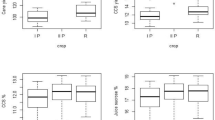Abstract
The experiment was planted with fourteen early maturing high sugar genotypes along with two standards (CoJ64 and CoS687) during spring season of 2003 in randomized block design with plot size of 10 × 3.75 m2 in three replications, which was harvested during 2004 and ratoon was maintained to study the correlation and path analysis among different agronomic as well as quality characters with ratoon yield. The results indicated that the variance for juice quality trait is high. All the quality parameters like juice brix, sucrose per cent in juice and commercial cane sugar percent (CCS%) had highly positive and significant genotypic correlation with Pol percent in cane during November. Among the characters studied, number of millable canes (NMC), single cane weight and cane height showed significant positive correlation with ratoon yield and sugar tonnes per hectare (STH) but there was a weak negative correlation between NMC and single cane weight. Path analysis study reveled that two characters namely NMC and single cane weight showed significant positive direct contribution towards cane yield. This cane weight was contributed by cane height to cane yield. Although all the characters which showed significant positive correlation were important but on the basis of path analysis NMC and single cane weight had contributed more for ratoon yield. Therefore, for selection of high ratoon yield in early maturing genotypes more emphasis on NMC and single cane weight would be of much importance.
Similar content being viewed by others
References
Cochran, W.G. and Cox, G.M. (1957). Experimental Designs. Kew: Jhon Wiley and Sons, Inc. New York, USA.
Das, P.K., Jena, B.C. and Nayak, N. (1997). Characters association and path analysis of sugar yield in sugarcane. Indian Sugar 46 (10): 805–808.
Ferraris, R., Chapman, L.S. and Ludlow, M.M. (1993). Ratooning ability of cane varieties: Interception of light and efficiency of light use Proc. Australian Soc. Sugar Cane Technol.15: 316–322.
Johnson, J.L., Heaglu, A.M., Zapata, H.O. and Ricaud, R. (1993). The impact of succession planting and a third ratoon crop on economic efficiency in sugarcane production in LousianaAm. Soc. Sugar Cane Technol.13: 28–32.
Milligan, S.B., Gravois, K.A., Bischoff, K.P. and Martin, F.A. (1990). Crop effects on genetic relationship among sugarcane traits. Crop Science 30 (4-6): 927–931.
Milligan, S.B., Gravois, K.A. and Martin, F.A. (1996). Inheritance of sugarcane ratooning ability and relationship of younger crop traits to older crop traits. Crop Science36: 45–50.
Nair, N.V., Nagrajan, R., Mathew M.D. and Sreenivasan, T.V. (1999). Components of yield and quality in intraspesific hybrids ofS. officinarum L. selected for ancillary use. Sugar Tech 1 (4): 124–127.
Rishipal, B.S., Chaudhari, A.S., Mehta, A.S. and Kadian, S.P. (1998). Studies on characters interrelationship in clonal generation of sugarcane(Saccharum complex hybrids) Indian Sugar, 47 (11): 907–911.
Salassi, M.E. and Giesler, G.G. (1995). Projected costs and returns- Sugarcane, Louisiana, 1995. Dep. Of Agric. Economics and Agric. Business, AEA Info. Series No. 132, LEAS, LSU Agric. Ctr., Baton Rogue, USA.
Singh, R.K. and Chaudhary, B.D. (1985). Biometrical methods in quantitative genetic analysis. Kalyani Publication, New Delhi.
Singh, R.K. and Singh, S.B. (2002). Stability in ratooning ability of early maturing sugarcane varieties for higher yield and recovery. Indian J. of Agric. Science 72 (12): 716–718.
Singh, I.S., Singh, R.R., Singh, S.B., (2003). Ratooning ability of early maturing sugarcane Varieties under Bhat soil. Cooperative Sugar, 35 (3).
Sundara, B., Sankaranarayanan and Batcha, M.B.G.R., (1992). Varietal characteristics affecting ratooning potential of sugarcane. Sugarcane, 6:1–4.
Sundara, B., (1997). Multiratooning potential of sugarcane varieties and management of multiratoons. Indian J. of Sugarcane Technology, 12(1).24–26.
Thangavelu, S. (2005). Internode length of sugarcane genetic stocks and its association with growth factors, nutrients, sucrose % in juice and yield of cane and sugar. Indian Sugar 40 (12): 1041–1048.
Thippeswamy, S., Kajjidoni, S.T., Salimath, P.M. and Goud, J.V., (2003) Correlation and path analysis for cane yield, juice quality and their component traits in sugarcane. Sugar Tech. 5(1 &2): 65–72.
Zhou, M. (2004). Stalk population control of yield, quality and agronomic traits of sugarcane population in early selection stages. Sugarcane International, 22(5): 20–26.
Author information
Authors and Affiliations
Corresponding author
Rights and permissions
About this article
Cite this article
Singh, R.K., Sudhir Pratap, S. & Singh, S.B. Correlation and path analysis in sugarcane ratoon. Sugar Tech 7, 176–178 (2005). https://doi.org/10.1007/BF02950610
Published:
Issue Date:
DOI: https://doi.org/10.1007/BF02950610




